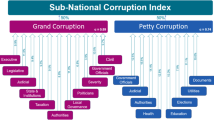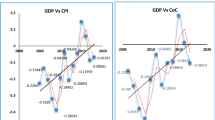Abstract
The aim of this study is to compare the levels of corruption control in the BRICS countries and in the G7 countries using data from 1996 to 2021 published by the World Bank. The corruption control data aims to present estimates on how corruption is controlled in the world. The BRICS countries include Brazil, Russian Federation, India, China, and South Africa, while the G7 group comprises the United States, United Kingdom, Canada, France, Germany, Italy, and Japan. This empirical benchmarking study presents both country and country-group-level analyses and results, which enable monitoring progress in corruption control in the global country groups and leading global economies. A key finding of the benchmarking study is that corruption control is higher in the G7 countries than in the BRICS countries. The average corruption control level in the G7 countries during the period 1996–2021 was 88, whereas in the BRICS countries, it was 43. The median and average corruption control difference was 40, which is a significant difference. The study reveals other relevant findings in the field of global corruption control and governance. In general, decision-makers in the G7 countries pay more attention to corruption control than those in the BRICS countries.
Access this chapter
Tax calculation will be finalised at checkout
Purchases are for personal use only
Similar content being viewed by others
References
Buchan, B.: Changing contours of corruption in Western political thought, c. 1200–1700. In: Barcham, E. (ed.) Corruption: Expanding the Focus, pp. 73–96. ANU Press (2012). https://doi.org/10.22459/cef.09.2012.05
Dearden, S.J.H.: The challenge to corruption and the international business environment. In: Kidd, J.B., Richter, F.-J. (eds.), Corruption and Governance in Asia, pp. 27–42. Palgrave, Houndmills (2003)
Fisman, R., Golden, M.: Corruption: What Everyone Needs to Know. Oxford University Press, New York (2017)
Camp, R.C.: Benchmarking: the search for industry best practices that lead to superior performance. Asq Press (1989)
Kurtz, C., Snowden, D.: The new dynamics of strategy: sense-making in a complex and complicated world. IBM Syst. J. 42(3), 462–483 (2003)
Snowden, D.J., Boone, M.E.: A leader’s framework for decision making. Harv. Bus. Rev. 85(11), 68–76 (2007)
Snowden, D., Rancati, A.: Managing Complexity (and Chaos) in Times of Crisis. A Field Guide for Decision Makers Inspired by the Cynefin Framework. Publications Office of the European Union, Luxembourg (2021)
Stapenhurst, T.: The Benchmarking Book. A How-to-Guide to Best Practice for Quality Managers and Practitioners. Routledge. Taylor and Francis, London and New York (2009)
Fontana, B.: Sallust and the politics of Machiavelli. Hist. Polit. Thought 24(1), 86–108 (2003)
Ekpo, M.U., Vine, V.L. (eds.): Bureaucratic Corruption in Sub-Saharan Africa, Toward a Search for Causes and Consequences. University Press of America, Washington (1979)
Klitgaard, R.: Controlling Corruption. University of California Press, Berkeley, CA (1988)
Mauro, P.: The Effects of Corruption on Growth, Investment, and Government Expenditure. Economic Growth, IMF Working Paper No. 96/98. International Monetary Fund. Washington D.C. (1996)
Nicholls, C., Daniel, T., Polaine, M., Hatchard, J. (eds.): Corruption and Misuse of Public Office. Oxford University Press, Oxford (2006)
Rose-Ackerman, S.: Corruption - A Study in Political Economy. Academic Press, New York (1978)
Hough, D.: Corruption, Anti-corruption and Governance. Political Corruption and Governance Series. Palgrave Macmillan, Basingstoke (2013)
Kijang, S., Onn, J.D.: Enhancing Government Effectiveness and Transparency. The Fight Against Corruption. Global Report. International Bank for Reconstruction and Development. The World Bank. Kuala Lumpur, Malaysia (2020)
Khan, M.M.: Economic research of corruption: its consequences. Res. Humanit. Soc. Sci. 8, 12–16 (2018)
Svensson, J.: Eight questions about corruption. J. Econ. Perspect. 19(3), 19–42 (2005)
Euben, J.P.: Corruption. In: Ball, T., Farr, J., Hanson, R.L. (eds.) Political innovation and Conceptual Change, pp. 220–46. Cambridge University Press, Cambridge(1989)
World Bank (1999). Fostering Institutions to Contain Corruption. PREM Notes No. 24, World Bank, Washington, DC
Howell, L.D.: The Handbook of Country and Political Risk Analysis. Political Risk Services. IBC USA Publications Inc., East Syracuse, N.Y.: PRS Group. (2001)
Kaufmann, D., Kraay, A., Mastruzzi, M.: Governance Matters III: Governance Indicators for 1996–2002. World Bank Policy Research Working Paper No. 3106, Washington, D.C. (2003)
Transparency International (2022). Corruption Perceptions Index 2022. Berlin, Germany. Web. https://images.transparencycdn.org/images/CPI2021_Report_EN-web.pdf
United Nations Development Programme (UNDP) (2005). Institutional Agreements to Combat Corruption: A Comparative Study, UNDP Regional Center, Bangkok
Boxwell, R.J., Jr.: Benchmarking for Competitive Advantage. McGraw-Hill, New York (1994)
Helgason, S.: International Benchmarking Experiences from OECD Countries. Paper Presented at a Conference organised by the Danish Ministry of Finance on: International Benchmarking Copenhagen, 20–21 February 1997. Copenhagen, Denmark (1997)
Quah, J.S.T.: Benchmarking for excellence: a comparative analysis of seven Asian anti-corruption agencies. Asia Pac. J. Public Adm. 31(2), 171–195 (2009). https://doi.org/10.1080/23276665.2009.10779362
Gemperle, S.M.: Comparing anti-corruption agencies: a new cross-national index. Int. Rev. Public Adm. 23(3), 156–175 (2018). https://doi.org/10.1080/12294659.2018.1518002
Quah, J.S.T.: Evaluating the effectiveness of anti-corruption agencies in five Asian countries: a comparative analysis. Asian Educ. Dev. Stud. 4(1), 143–159 (2015)
Recanatini, F.: Anti-corruption authorities: an effective tool to curb corruption? In: Rose-Akerman, S., Soreide, T. (eds.) International Handbook on the Economics of Corruption, Chapter 19, pp. 528–564. Edward Elgar Publishing (2011)
World Bank (2023). Corruption Control. Worldwide Governance Indicators. World Bank. Voice and Accountability; Political Stability and Absence of Violence/Terrorism; Government Effectiveness; Regulatory Quality; Rule of Law; Control of Corruption. Web. https://databank.worldbank.org/source/worldwide-governance-indicators
Acknowledgments
Research Director Jari Kaivo-oja is a researcher at the Strategic Research Council of the Academy of Finland, in the Manufacturing 4.0 project. The project Manufacturing 4.0 has received funding from the Finnish Strategic Research Council [Grant number 313395].
Author information
Authors and Affiliations
Corresponding author
Editor information
Editors and Affiliations
Rights and permissions
Copyright information
© 2023 The Author(s), under exclusive license to Springer Nature Switzerland AG
About this paper
Cite this paper
Kaivo-oja, J., Santonen, T. (2023). Corruption Control in the BRICS and in the G7 Countries: A Benchmarking Study with World Bank Data Files from Years 1996–2021. In: Uden, L., Ting, IH. (eds) Knowledge Management in Organisations. KMO 2023. Communications in Computer and Information Science, vol 1825. Springer, Cham. https://doi.org/10.1007/978-3-031-34045-1_16
Download citation
DOI: https://doi.org/10.1007/978-3-031-34045-1_16
Published:
Publisher Name: Springer, Cham
Print ISBN: 978-3-031-34044-4
Online ISBN: 978-3-031-34045-1
eBook Packages: Computer ScienceComputer Science (R0)




